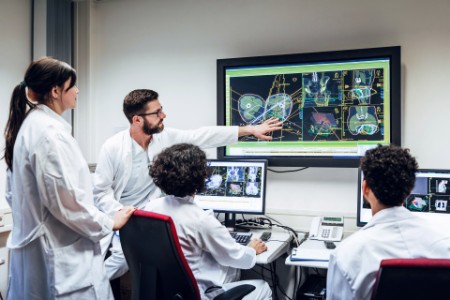
Chapter 1
AI - a breakthrough in innovation
Potential for speed, relevance and efficiency in pharmaceutical R&D
It typically takes
12-15years to get a drug to market
Besides being time-consuming, drug development is an expensive and risky business, with a clinical trial failure rate of up to 90% and average cost of USD 2.6 billion.
While AI cannot replace clinical studies as a vital step in safe drug development, it can help focus resources onto the most promising compounds, which accelerates processes, reduces risk of failure and cuts costs. AI-based drug-discovery applications use machine learning to identify candidates and predict their interactions in vivo, enabling the research team to better prioritize their efforts.
Once a product is ready to move from bench to bedside, AI can help select sites and support the process of identifying the right patients for a clinical trial. A world leading analytics provider in healthcare, has seen enrolment rates to clinical trials increase more than 20% and automatic processing of adverse drug reactions in 70% of cases.
AI isn’t just being used in early research and to plan clinical studies. Natural language processing (NLP) is also increasingly finding its way into medical applications. NLP can be used to search, analyze and interpret large amounts of patient data. Data sources can be as diverse as discussions in public health forums, social media posts or electronic health records. For example, large pharmaceutical companies already gained a label expansion for the drugs, partially based on NLP analysis. Data for the analysis was sourced from electronic health records and three databases containing post-marketing reports of real-world use of the drug in male patients. Real-world evidence is also supporting clinical studies. By serving as a synthetic control arm, it’s especially useful in the case of rare conditions where traditional patient recruitment would take too long. Speeding up the clinical trial benefits both patients and drug developers.
Considering the huge impact that AI can have on R&D and the large investments made by pharma companies, it’s surprising that pharmaceutical companies are generally hesitant adopters. A 2019 review paper found that just 18 AI-related patent applications had been submitted by the top 20 pharma companies (by revenue) in recent years, compared to thousands by technology companies. In terms of investment in AI, the healthcare industry will rank behind banking, manufacturing, retail and the public sector in 2021 according to Atos, a global leader in digital transformation.

Chapter 2
Physicians plus AI – a partnership for patients
Taking AI from R&D to clinical practice and better patient outcomes
When it comes to technology in healthcare, much effort and budget is concentrated in processes and customer service, where tools like speech recognition and computer vision are boosting the customer experience. But the core business of frontline healthcare – diagnostics, treatment and monitoring – is lagging behind other industries.
Machines will not replace physicians, but physicians using AI will soon replace those not using it.
While adoption may be slow, it is more a question of when, not if, uptake will increase. The experience and expertise of the physician will remain a valuable resource, but AI has the potential to enhance care through:
- Quicker diagnostic procedures
- More accurate clinical decision-making
- Better patient experience and outcomes
- Improved cost management
An example covering all of these aspects is the software solution SubtleMR™, which improves the quality of accelerated head, spine and neck MRI protocols using super resolution and denoising. Patients spend less time being scanned, improving their experience, and more patients can benefit from scanning facilities in any one day. Better quality images reduce the need for repeat scans, and can also help limit the dosage of contrast agents.
In the new healthcare ecosystem, data-driven technology like AI can be the glue that connects two parties to create exciting new applications and opportunities. Here are some more examples of how patients benefit from tech-augmented healthcare when their physicians embrace new tools and technology:

Chapter 3
The data challenge
Data plus algorithms equals successful machine learning. But which data?
To gather data, healthcare companies need to transform deeply to become data-driven organizations. Pharmaceutical companies are built to collect and use data, but in a very traditional way and with a defined purpose. As a result, data silos are often created, and companies need to break these down and integrate all of their data across countries, trials, applications and assets. They should also strive to leverage data that is generated outside the organization. Truly data-driven companies transform from within. That means embracing new technology, entering into new partnerships and shedding the fear of the unfamiliar. If they really want to leverage the potential of tech, there’s no way round the need to invest: in infrastructure, tools and training. Forward-thinking CEOs acknowledge the importance of this despite any concerns about initial outlay. Having a data mindset, where IT is seen as a driver rather than a cost center, helps in integrating data collection along the value chain.
Healthcare stakeholders need to learn to gather data from the entire health ecosystem. That applies to pharmaceutical companies but also the surrounding healthcare systems including payers and patients. Capturing data more widely is beneficial to all the players involved but relies on collaboration in the healthcare ecosystem. Even if healthcare organizations have the data infrastructure required to collect adequate data to support machine learning, they often lack the in-house expertise to truly extract value. Many fail to ask the right questions or struggle to explore exciting new use cases. Strategic partnerships with disruptive market entrants like technology companies can prove mutually beneficial. An outside view can also help distill information and derive value for all stakeholders. For example, EY helped to develop a strategic business case for a clinical AI company in the UK to identify the commercial value of data.
Data integrity and confidence is key – not just between patients and their healthcare providers, but within the entire healthcare ecosystem. Targeted external assurance can help. EY has supported clients in the healthcare space to identify and prove AI use cases and develop market maturity based on real medical data.
Finally, one last major challenge to realizing the full potential of AI technology in healthcare is legal concerns. Software that informs diagnosis or treatment decisions is the most heavily regulated category of medical devices, and developers are required to prove reliability adequately to meet rigorous standards. The process can prove prohibitively expensive. Then there’s the issue of liability: who is responsible if the algorithm makes a mistake? This is a rapidly evolving topic with no consensus answer to date.

Chapter 4
Subjects vs. stakeholders
Who owns data?
For most people, the intuitive answer would be the patient. In an opinion piece from 2020, the British Medical Journal proposes a definition of ownership as being “the ability to utilise information (i.e. reproduce, sell etc), control the flow of that data for use or restrict it to preserve privacy, and the responsibility to avoid harmful information release”. If this is true, then there are multiple owners. In fact, all stakeholders that invest time, funding or resources in processing and protecting data can claim some degree of ownership in the outcome. As the data subject, then, the patient co-owns data with organizations, governments and society. This doesn’t mean that patient data doesn’t deserve – and require – the highest level of privacy and security.
A rigorous data privacy policy should always be embedded in the tech strategy and applied without exception. This is true even when patients themselves are not that careful with their own data. For example, if a patient posts health information on social media, that data may be used as a valuable resource provided it is anonymized and included in databases in accordance with relevant laws. Existing data protection legislation like the GDPR in Europe is necessary, but the high cost of compliance can mean that well-funded incumbents may have an unfair advantage over start-ups. A common data schema for storage and transfer of healthcare data could make it easier for all parties in the healthcare ecosystem, e.g., through a generalized data infrastructure or commercially available cloud storage.

Chapter 5
Preparing for the potential of AI
Four steps toward the future
Huge breakthroughs in personalized medicine – and ultimately better patient care and outcomes – are significantly enabled by the potential of data analytics and digitally enabled business models. For unprecedented data volumes and emerging technologies to deliver on their promise, the healthcare ecosystem needs to include data acquisition and retention into strategy, and ensure that this is underpinned by confidence. The healthcare ecosystem stands to benefit hugely from digital developments - if it can get the foundations right. EY has identified four key steps on this journey:
- Build an ecosystem based on partnerships that bring together life sciences expertise and AI know-how
- Embrace a data mindset, seeing IT as a driver rather than a cost center and integrating data collection to all sides of the business
- Embed ethical aspects in AI design by safeguarding transparency, avoiding bias and ensuring accuracy and appropriateness in an individual context
- Establish strong processes to ensure data confidence, and reinforce trust through third-party assurance
Summary
Although the healthcare ecosystem recognizes the potential of AI, many players still struggle to embrace change, develop the necessary data landscape and redefine structures. Faced with high costs and complex data protection questions, it can be difficult to break down silos and truly transform. Healthcare players need to connect and collaborate more and see technological disruption as the transformative opportunity it is.
Acknowledgements
Special thanks go to Laura Jochem, Nadja Bekele and Josselin Meylan for their valuable contribution to this point of view article.

